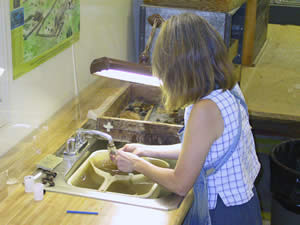What does it all mean? Analysis and Interpretation
 Although the most visible part of archaeology happens in the field, archaeologists spend more than half their time in the laboratory. Here they analyze and interpret their findings, and assemble them in a technical report.
Although the most visible part of archaeology happens in the field, archaeologists spend more than half their time in the laboratory. Here they analyze and interpret their findings, and assemble them in a technical report.
A data recovery dig like the one in Danville can yield thousands of artifacts. Identifying artifacts and inventorying them in a database provides one of the key interpretive tools for understanding a site. The database can be queried for information on different types of artifacts from the site as a whole, or from individual features or soil strata, for example. Field notes and drawings are also examined for interpretation of the site and comparisons with other similar sites—and ultimately to answer some of the broad questions of the research design.
Finally, the archaeologist assembles the information into a detailed descriptive and interpretive technical report aimed at other researchers. Ideally, the archaeologist will also make the information accessible to the public through other media like this website, booklets, brochures, or exhibits.
 Skip to main content
Skip to main content
